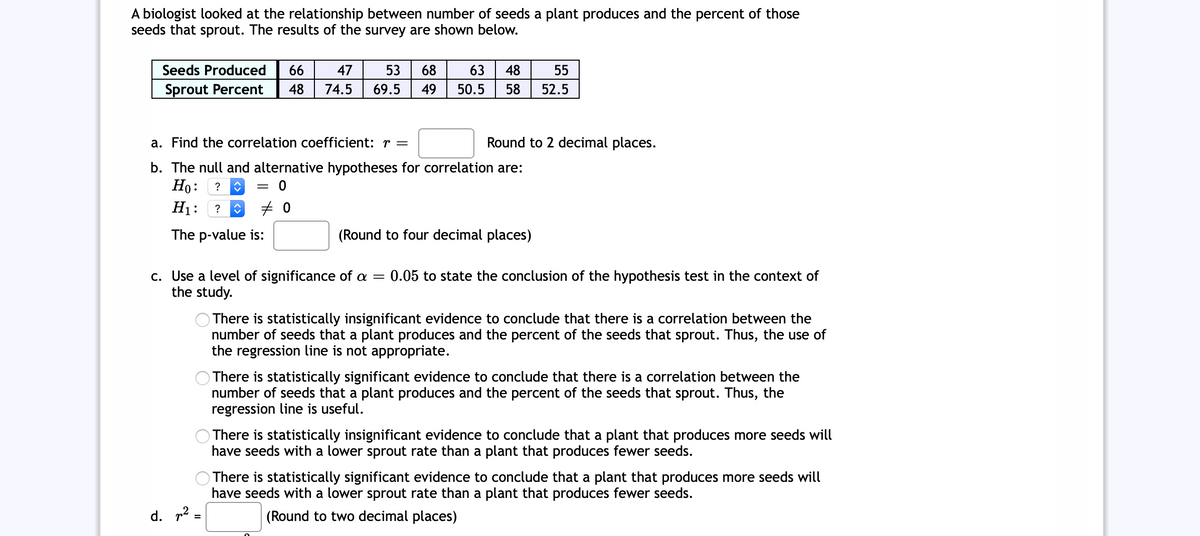A biologist looked at the relationship between number of seeds a plant produces and the percent of those seeds that sprout. The results of the survey are shown below. Seeds Produced 66 47 53 68 63 48 55 Sprout Percent 48 74.5 69.5 49 50.5 58 52.5 a. Find the correlation coefficient: r = Round to 2 decimal places. b. The null and alternative hypotheses for correlation are: Ho: ? H1: ? O 0 = 0 The p-value is: (Round to four decimal places) c. Use a level of significance of a = 0.05 to state the conclusion of the hypothesis test in the context of the study.
A biologist looked at the relationship between number of seeds a plant produces and the percent of those seeds that sprout. The results of the survey are shown below. Seeds Produced 66 47 53 68 63 48 55 Sprout Percent 48 74.5 69.5 49 50.5 58 52.5 a. Find the correlation coefficient: r = Round to 2 decimal places. b. The null and alternative hypotheses for correlation are: Ho: ? H1: ? O 0 = 0 The p-value is: (Round to four decimal places) c. Use a level of significance of a = 0.05 to state the conclusion of the hypothesis test in the context of the study.
Glencoe Algebra 1, Student Edition, 9780079039897, 0079039898, 2018
18th Edition
ISBN:9780079039897
Author:Carter
Publisher:Carter
Chapter4: Equations Of Linear Functions
Section4.5: Correlation And Causation
Problem 11PPS
Related questions
Concept explainers
Equations and Inequations
Equations and inequalities describe the relationship between two mathematical expressions.
Linear Functions
A linear function can just be a constant, or it can be the constant multiplied with the variable like x or y. If the variables are of the form, x2, x1/2 or y2 it is not linear. The exponent over the variables should always be 1.
Question
please solve A, B, and D
ch 12

Transcribed Image Text:A biologist looked at the relationship between number of seeds a plant produces and the percent of those
seeds that sprout. The results of the survey are shown below.
Seeds Produced
66
47
53
68
63
48
55
Sprout Percent
48
74.5
69.5
49
50.5
58
52.5
a. Find the correlation coefficient: r =
Round to 2 decimal places.
b. The null and alternative hypotheses for correlation are:
Но:
H1:
?
The p-value is:
(Round to four decimal places)
c. Use a level of significance of a =
the study.
0.05 to state the conclusion of the hypothesis test in the context of
There is statistically insignificant evidence to conclude that there is a correlation between the
number of seeds that a plant produces and the percent of the seeds that sprout. Thus, the use of
the regression line is not appropriate.
There is statistically significant evidence to conclude that there is a correlation between the
number of seeds that a plant produces and the percent of the seeds that sprout. Thus, the
regression line is useful.
There is statistically insignificant evidence to conclude that a plant that produces more seeds will
have seeds with a lower sprout rate than a plant that produces fewer seeds.
There is statistically significant evidence to conclude that a plant that produces more seeds will
have seeds with a lower sprout rate than a plant that produces fewer seeds.
d. p2 =
(Round to two decimal places)
Expert Solution
This question has been solved!
Explore an expertly crafted, step-by-step solution for a thorough understanding of key concepts.
This is a popular solution!
Trending now
This is a popular solution!
Step by step
Solved in 4 steps

Knowledge Booster
Learn more about
Need a deep-dive on the concept behind this application? Look no further. Learn more about this topic, statistics and related others by exploring similar questions and additional content below.Recommended textbooks for you

Glencoe Algebra 1, Student Edition, 9780079039897…
Algebra
ISBN:
9780079039897
Author:
Carter
Publisher:
McGraw Hill

Glencoe Algebra 1, Student Edition, 9780079039897…
Algebra
ISBN:
9780079039897
Author:
Carter
Publisher:
McGraw Hill